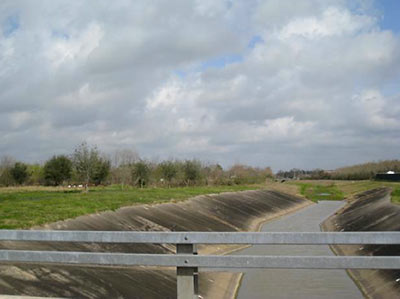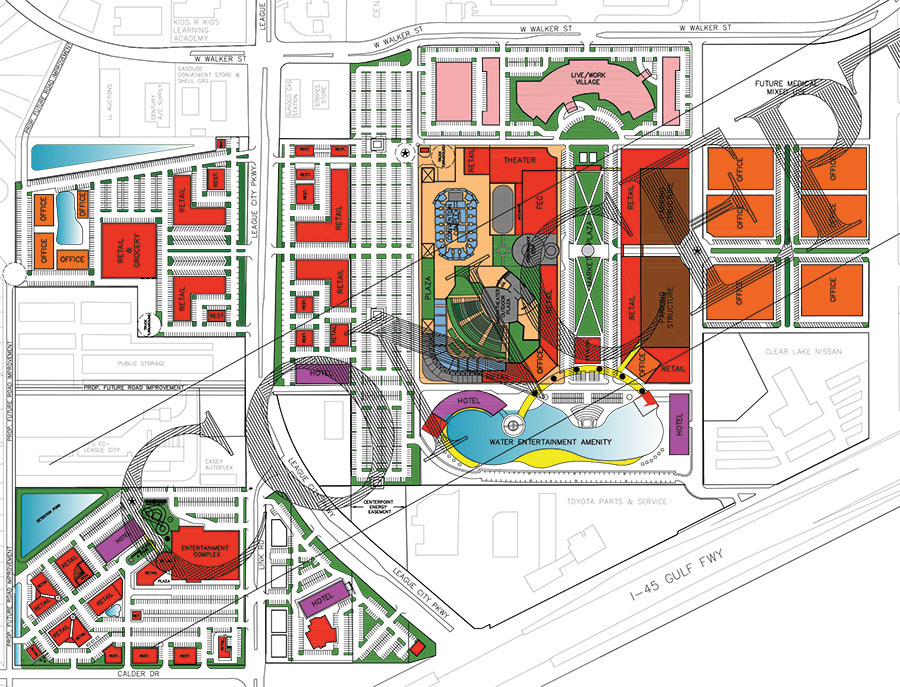
Residents of the Magnolia Creek subdivision in League City are protesting plans by developer Lynn Watkins to drill for oil and natural gas on a 3-acre site next to a daycare center near the corner of League City Parkway and Bay Area Blvd. To gain the drilling permits, Watkins would need to rezone the land to light industrial. Abc13’s Kevin Quinn reports:
Those who purchased homes say they were told the land is zoned as commercial. They expected a strip mall of some sort to be built here — not a drilling rig that stands 131 feet tall. Dozens of homeowners have signed a petition asking the city not to grant the special use permit the developer seeks. . . .
[Watkins] insists there would be minimal impact to the surrounding neighborhood and schools.
Additional traffic, he insists, would be less than that coming and going from a home being built in the neighborhood. He says also of the 400,000 operational wells across the state, there have been only 900 blowouts in the past 30 years. Those, he says, resulted in 131 injuries and nine deaths.
“In that same period, there’s been 90,000 traffic deaths on Texas highways in that same period,” Watkins said.
***
Meanwhile, 6 miles to the east, a separate group of neighbors is fighting a Houston drilling company’s plans to put in a drilling rig and a pipeline on a 2.8 acre site just northeast of the intersection of Texas Ave. and Austin St. The pipeline would make its way west to Dickinson Ave. League City’s planning and zoning commission voted down Forza Operating LLC’s request to rezone the site from single-family residential on September 13, but an altered version of the proposal will come up again on October 18th. Rezoning for both the Magnolia Creek and the Texas Ave. drilling sites require a vote from League City’s city council.
- Residents fight plan to build drilling rig in neighborhood [abc13]
- Homeowners fight possibility of oil and gas drilling near League City neighborhood [11 News]
- Neighbors: No to drill, baby, drill [Galveston Daily News]
Photo of Forza Operating proposed drilling site: City of League City





Just curious at to what the proximity of a daycare center has to do with the price of tobacco in Virginia.
Death by oil drilling
Compared to death by traffic…
Welcome to Texas.
In Texas, if they are going to be handling sour gas (in TX, this is 25 ppm H2S or higher) needs to be at least 1/4 mile from a residence or recreational area. I’m not sure what Gus meant by “right next to” the day care, but looking at the satellite, I think it would easily be within 1/4 mile. So this shouldn’t be a sour facility, so hopefully the H2S risk is low.
That’s at least one requirement. There are others I’m sure I’m forgetting.
Embrace it, suburbanites. You could learn a thing or two from Barnsdall, Oklahoma. They put an oil well smack dab in the middle of Main Street. Years later, a woman in the town spawned Anita Bryant, who became known for her hysterical religious activism against gays. I argue the events are related. Maybe it’s the drinking water. Or maybe it’s Karma.
If we could prove that oil wells make nearby children go nutty right-wing, then I bet suburbanites everywhere would be clamoring to get one drilled in their back yard.
Superdave, thanks for a laugh. I needed one today.
I wonder what Anita has been up to lately….
I wonder how many drill baby drill folks are near there.
From Jason:
“I wonder how many drill baby drill folks are near there.”
——————-
I don’t know. Define the term “drill baby drill folks” and then let’s speculate.
I believe the easiest way to define them is…the people who were standing around yelling it at the top of their lungs in nov 2008. “We need to drill HERE and drill NOW”. Now get to speculating.
Well, guessing that there are about 500 or less within a half mile of this intersection, I would say the probability of finding just one such person who meets your strict and quite precise definition is close to zero.
Meant to imply 500 or fewer households.
If only people who commute less than 20 miles per day are allowed to sign, then more power to them.
If you’re not part of the solution, Magnolia Creek, then you’re part of two problems.
Developer sells out an 1100 home community starting 1999. Only sale in the commercial zone to a daycare. All home owners “assured” zoning was solid.
Sells land in question to “town center” developer who goes broke, land reverts back to the bank, and miraculously after foreclosure a carefully placed well request appears…50 ft either way and doesn’t meet any ordinance. Developer asking for zoning change does not own land – financing for development is contingent on the zoning change (drilling).
Many Texas muncipalities would not come close to meeting setback – and current zoning has to be changed to drill. Daycare is 300-400 ft, 200 kids…in a building sold BEFORE the request to change zoning or disclose any intent.
Before complaining about hypocrites and NIMBY don’t ignore withheld info. Surely the developer would have sold the 1100 homes and commercial building a lob wedge away from a daycare playground to the planned well because everyone wants to live by one – after they moved in. A simple refund is all one asks for.
Add in that it could have been easily done 10+ years ago, but that would have required 1000 feet setbacks and would have eliminated much of the profit from the “assured zoned” residential area.
Sounds like it’s soon to be another neighborhood with flammable tap water. “Drill, Baby, Drill!” “BOOM!”
http://en.wikipedia.org/wiki/Gasland
Kilray, does League City get it’s water from groundwater or is it from the surface?
.
Plus, wasn’t the flammable tap water shown in that movie naturally occurring in that water, and not related to recent drilling in the area?
eiioi, yeah, I’m sure most of League City gets its water pumped in from surface sources. I was mostly joking about the likelihood of flammable water, but not about the possibility of gases migrating to the surface or into ground water. Maybe things are safer these days and fracturing isn’t an issue here.
It was my understanding in “Gasland” that it was the drilling company’s contention that the flammable tap water must be naturally occurring without any proof to the contrary. For residents, proving the origin of gas contamination in their water supply was quite difficult. You be the judge.
If you look at production data, Galveston County is currently producing around 30000 BOE (barrel of oil equivilent) per month on over 20 wells. One of the fields that is producing is less than 1000ft off 45 just south of Kema. Depth of producing interval is around 4000ft.
I have a hard time believing that moving a rig out there for about the 3 weeks it takes to drill a well to 3000ft, set casing, and complete it to a producing well, would be any worse than having some tacky strip mall taking 6 months to construct.
I would point out that most environmental experts state that “fracking” has the potential to contaminate surface water as well.
My only question about the process is that if “fracking” is so safe and isn’t a threat to drinking water, why did the Energy Policy Act of 2005 exempt “fracking” from federal regulation under the Safe Drinking Water Act? If the procedure is so safe, why the need for the exemption?
Martin,
Fracing is done in every well drilled in the last few decades; this is not my specialty area, but this is my impression. Fracing is fracturing the area around the well bore and blowing holes in the (metal) well casing to let the fluids flow in.
Fracturing the source rock as a whole is done in limited applications for only some types of rock, like shale. This is what is called non-conventional.
Both types have the potential to contaminate drinking water zones (in areas where the groundwater is used as drinking water) and I think everyone would agree with this. If you were to apply to drill a well in a “conventional” reservoir, you would have to demonstrate that you won’t contaminate any drinking water zones with oil, drilling fluids, or salt water. If you do contaminate, there are consequences. I imagine the case is the same for shale gas or tight gas plays too.
Martin,
Why the exemption in 2005? Without researching the intent or the Federal Register, I imagine that the SDWA was set up to regulate all discharges of water into the environment.
Injection wells, where saltwater from O&G operations is injected into the ground,
are covered by the SDWA. This water is injected continuously at a high volume, and can even increase quite a bit as the well matures. As an illustration, you might get 3,000 bbl/day but have to injection 200,000 bbl/day. Plus, you are injecting at high pressure and not getting any return from the ground (reservoir pressure maintenance aside), so the likelihood that the injected water will enter another zone is higher.
Compare this with fracturing, which is done only once as the well is being drilled (and yes, for workovers too) and not continuous, is a low volume, and you’re getting a return of fluids to the well and then out of the ground (the reverse of pressuring into a drinking water zone).
I think it was probably deemed less of an environmental and public health issue than saltwater disposal by injection downhole, which has been occurring for decades, therefore the exemption.
I seriously doubt that the government determined that fracturing was more dangerous, and used that as a basis to grant an exception.
Horizontal “fracking,” which is the process often used to abstract natural gas from shale formations (such as the Marcelles Shale), has a greater potential to contaminate drinking water due to the horizontal nature of the hole. One hole (moving horizontally through the formation, rather than vertically), has the potential to come into contact with more sources of drinking water. I’m not an expert either but that is my understanding (and it makes sense).
As far as the reasoning behind the exemption, I have my suspicions given (a) the party in power in Congress at the time and (b) the President in power (and his connections with the oil and gas industry) at the time. But again, this doesn’t answer the ultimate issue; if the fracking process does not pose a real threat to drinking water, then the exemption would not be needed. Such an exemption would only be needed if the process couldn’t be carried out without the exemption.
One hole (moving horizontally through the formation, rather than vertically), has the potential to come into contact with more sources of drinking water.
==============
Could you find an area where this is true? Sure, some.
1. But in general, you are going to come into contact with many, many, many, many more geologic zones drilling vertically for 20,000 ft. than you are driling horizontally for the same distance. The Wolfcamp play, for instance is in 4 counties in West Texas, but around the same depth.
2. And over land, you won’t see the very long extended reach horizontal drilling that you would offshore as much because of a. higher cost per well there or b. drilling out to sea as far as possible from land.
3. Drilling for hydrocarbons in shale is just that. When they are drilling, they don’t just willy-nilly drill horizontally (0 degree angle instead of 90 or 57 or 13); they drill to target the zones with the hydrocarbons and shale, not the drinking water.
4. Except for some infill drilling in old fields in shallow reservoirs in easily accesible areas to drill (e.g., Bakersfield or the North Permian), MOST wells nowadays – of any kind, shale or not – have some horizontal component to the drill path and are not strictly vertical wells. No one is making the point, nor could they make the point that angled well paths are inherently more dangerous to the public health because there would be no evidence to support the claim.
“But again, this doesn’t answer the ultimate issue; if the fracking process does not pose a real threat to drinking water, then the exemption would not be needed.”
——————
I am not a trucker. When I drive my car, I don’t have and am not legally required to have:
-DOT drug tests
-weigh-ins of my vehicle
-manifests for my goods
-log book for my hours of driving to show I followed the speed limit and got enough sleep
Without these and many other controls in place for truck drivers, driving a truck would be a much more dangerous activity to the general public than driving a small automobile.
However, using the logic in your quote above, you seem to suggest that small cars are inherently more dangerous than trucks simply because they are exempt from many regulations. There’s no way every car owner could comply with these regs, and they would in effect be put out of business.
Fracturing is likely exempt from the SWDA because compliance would be more onerous without additional benefit to the public, not because it’s more dangerous.
I bet the owners of these drilling companies live NO WHERE close to their drilling sites! Makes me angry that League City would CONTINUE to allow them to freaking “FRACK”!